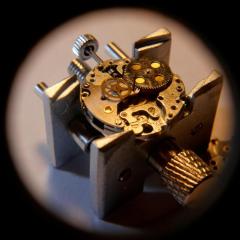How Does The Timegrapheror Vibrograph Measure Amplitude?
-
Recently Browsing
- No registered users viewing this page.
-
Topics
-
Posts
-
Just received today: For only ~60$ * (*) ~140$ with shipping and custom fees. 3.80 Kg The pressure should rise to 6 bars. The glass is thick The closing system seems to be sturdy. I'll submersible locking system (I will make a notch on top to note the opening position): I put 3 bars at let it for 20 minutes, the pressure didn't leaked at all. Next steps: Quick wash, maybe put some silicone grease on the seal of the lid ? First test I'll do: Put deionized water til the red line Put a diver case in the tank, keep it outside the water Pump (10 ~ 20 times?) to reach 3 bars (0.3MPa) Wait at least 1 minute Dip the case into the water Gently release the pressure and observe To be continued... All comments are welcome
-
Hi all - I was just watching Clickspring's series making a custom faceplate and he demonstrates the "wobble stick" technique for centering. I was already familiar with this and it is all straightforward. But how does one set the height of the T rest so that it acts as a truly level fulcrum? Or does it actually matter if the fulcrum is perfectly level with the hole you're trying to center? As I type this I'm realizing there should not be any motion at the other end of the stick even if it is at an angle relative to the work, and isn't pointing even with the tailstock center. Do I have that right?
-
Typically watch manufacturing companies will purchase parts to their exact specifications including the jewels. This means that typically you may not find an exact generic replacement. I'm attaching a PDF of a book that explains how to replace jewels. Seitz book.pdf
-
Hey everyone! I sure this topic has probably been discussed before, but I want some good recommendations based on experience or knowledge about a good affordable high torque DC motor that I can use for my lathe. I have a little lathe but it has the regular old style motor that was used in the past with a foot controller. However, I would like to improve it by buy a nice motor with a speed controller so I don’t have to use my foot. I would like the motor to have really good torque so that even if I run it at a very low speed, it still can cut material easily. I saw online this brand called Servo sewing machine motor with a speed controller, but I don’t know how good they are and if they would work like I would like to for my lathe. Thank you for all the help!
-




Recommended Posts
Join the conversation
You can post now and register later. If you have an account, sign in now to post with your account.
Note: Your post will require moderator approval before it will be visible.